| |
| ... |
|
|
|
|
|
| |
| December 04-05, 2004 |
|
Weekend 11: The Season Comes to an End
The final weekend of the Fall collecting season at PCS saw members from the North Carolina Fossil Club, Aurora Fossil Club, North Carolina Shell Club, Columbus (Ohio) Gem and Mineral Club, Dry Dredgers (Cincinnati, OH) and several non-club affiliated collectors, all hoping the last days of the season would reveal that elusive 'bubba' meg. Bubba remained hidden, but other finds were much appreciated.
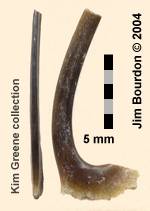 On Saturday four small Carcharocles teeth surfaced with Matt Lentz' two 2-1/4 inch Pungo specimens being the largest. Paul Fam-Hemel found a 1-7/8" Yorktown lateral and Ken Young a posterior. Sunday's 'megs' included a 2-3/8" (George Powell), 2-1/2" (Judy Stiles), 1-7/8 & 11/16" posterior (Kim Greene), 1-1/2" lateral (Sharron Edwards), 2" (Bob Bross) and two chubbies (a lateral and a posterior) found by Jim Bourdon. Daniel Beane recovered a beautiful 2-1/2" perfect Pungo specimen in matrix. Notorynchus teeth on Saturday numbered ten lowers, two uppers and Mike Murrow 's symphyseal; Sunday's finds included an amazing eight lowers found by Kim Greene and one each by John Everette & Patsy Godwin. Becky and Ellie Rouse each found uppers. Both days saw large Cosmopolitodus hastalis teeth found by Keith Robertson, Dick Marshall, Anita Smith, Kim Greene, Ellie Rouse and Duane Hubbard (who found four two-inch specimens). More unusual tooth finds included Saturday's two prickly shark teeth (E. cookei) by Ken Young & Eric Sadorf, a perfect Carcharoides catticus by Michael Dunn and Sunday's two Squatina subserrata found by myself and Becky Hyne (who also found a C. catticus). Other shark related fossils were a Cetorhinus parvus (basking) gill raker found by Kim Greene (see image) and a shark rostral node.
On Saturday four small Carcharocles teeth surfaced with Matt Lentz' two 2-1/4 inch Pungo specimens being the largest. Paul Fam-Hemel found a 1-7/8" Yorktown lateral and Ken Young a posterior. Sunday's 'megs' included a 2-3/8" (George Powell), 2-1/2" (Judy Stiles), 1-7/8 & 11/16" posterior (Kim Greene), 1-1/2" lateral (Sharron Edwards), 2" (Bob Bross) and two chubbies (a lateral and a posterior) found by Jim Bourdon. Daniel Beane recovered a beautiful 2-1/2" perfect Pungo specimen in matrix. Notorynchus teeth on Saturday numbered ten lowers, two uppers and Mike Murrow 's symphyseal; Sunday's finds included an amazing eight lowers found by Kim Greene and one each by John Everette & Patsy Godwin. Becky and Ellie Rouse each found uppers. Both days saw large Cosmopolitodus hastalis teeth found by Keith Robertson, Dick Marshall, Anita Smith, Kim Greene, Ellie Rouse and Duane Hubbard (who found four two-inch specimens). More unusual tooth finds included Saturday's two prickly shark teeth (E. cookei) by Ken Young & Eric Sadorf, a perfect Carcharoides catticus by Michael Dunn and Sunday's two Squatina subserrata found by myself and Becky Hyne (who also found a C. catticus). Other shark related fossils were a Cetorhinus parvus (basking) gill raker found by Kim Greene (see image) and a shark rostral node.
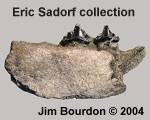 Mammal material was well represented by Jim White's stunning seal molar, Eric Sadorf's partial seal jaw (5.3 x 2.8 cm) with two teeth intact (see image), and several Squalodon molars and canines. Jim Shelton, and several others found whale teeth. One crocodile tooth was reported on Saturday. Outstanding examples of bird bones continue to be found. George Powell's large turtle caudal vertebra (see image) was considered quite a curiosity.
Mammal material was well represented by Jim White's stunning seal molar, Eric Sadorf's partial seal jaw (5.3 x 2.8 cm) with two teeth intact (see image), and several Squalodon molars and canines. Jim Shelton, and several others found whale teeth. One crocodile tooth was reported on Saturday. Outstanding examples of bird bones continue to be found. George Powell's large turtle caudal vertebra (see image) was considered quite a curiosity.

In closing, I think the season was very productive with a wide variety of fossils in good condition being recovered. I'm sure we'd all like to thank the PCS Phosphate Safety and Public Affairs Dept. (especially Curtis Ormond, Sr.) for once again allowing access to 'the pit' and look forward to the upcoming Spring season.
|
| November 27, 2004 |
|
Weekend 10: It's Getting Cold & Wet
Pat Young reports:
A clear, cool and pleasant 40 degrees greeted members of the North Coast Fossil Club (Cleveland, OH), Green Hope High School Staff (NC) and independent fossil collectors from New York, Virginia, and North Carolina. The largest meg, a Pungo Carcharocles chubutensis, was found by Anna Lemoigne (4-1/8"). Others were found by Gael Decoudu (3-1/2"), Bonnie Forrester (2-1/2" lateral) and Becky Hyne (1-1/2" lateral). Two others in the 3-1/2" range were seen. Light rain began near noon, and seemed to highlight the areas to some of the more elusive fossils. Upper and/or lower Notorynchus teeth were found by Becky, Rita McDaniel, Paul Regel, Stan Wall, Debbie Wall, Valerie Everette and myself. Rita and Becky each found lower symphyseal teeth — Becky's showing a fan pattern and Rita's having a stout central cusp. Ken Young brought out a stunning black bramble shark tooth.
Other interesting finds include Squalodon molars by Becky and Valerie Everette, bonita tail verts (Beth Krumhansel & Paul Regel) and skate/ray dermal scutes by Ron Edwards (2), Kim Greene (a nice double), Valerie Everette and Paul Regel. Outstanding finds include a tautog premaxilla (Gael Decoudu) and an Arbacia sp. echinoid (Paul Reigle). John Everette, who apparently has given up his quest for the showier fossils, proudly showed off a perfect Cynoscion regalis (Grey trout/weakfish) otolitih. Whale material continues to be popular with Pam Gentry, Paul Carlow and others bringing out buckets full of verts. A few small whale teeth were also found.
|
| November 20, 2004 |
|
Weekend 9: Warmer Weather & Results
Pat Young reports:
With clear skies, slight breezes and temperatures in the low 70's, Saturday was considered the perfect fossil collecting day by members of the Gem, Lapidary and Mineral Society (MD), Old Dominion Earth Science Society and National Capitol Fossil Society. The twenty-four collectors wasted no time in boarding the bus after hearing of the greatly expanded collecting area.
It appeared that the majority of the collectors spent considerable time in the Pungo sediments. Carcharocles chubutensis were reported by Pat Young (3-1/2"), Ken Young (3-1/4"), Chris Milensky (2-7/8"), Gary Grimsley (1-7/8 & 1-3/4") and Carla Dove (1-1/2" posterior). Two outstanding specimens in matrix were found by Jim Savia (3") and Keith Robertson (2-3/8"). Grady Frame reported two Yorktown C. megalodon teeth (3 & 2-7/8"). Cosmopolitodus hastalis seemed to be the Yorktown tooth-of-the-day, with most collectors finding three or more large ones (largest found by Josh King). Several Notorynchus teeth (uppers and lowers) were seen. Jennifer Wingard found a grossly pathologic tooth tentatively identified as Carcharhinus obscurus (dusky) as well as a partial Hexanchus tooth. George Oliver recovered a perfect jet black E. blakei with a white root (his first). Colorful P. contortus, Hemipristis, dolphin/porpoise teeth and other Pungo offerings were abundant.
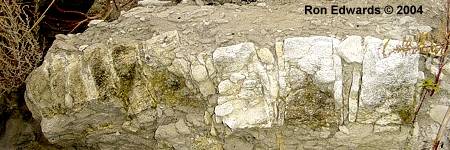
Other notable finds were: sperm whale tooth (Gray Grimsley), crocodile tooth (Grady Frame), Squalodon molars (George Oliver & Eric Sadorf), wahoo jaw with five complete teeth (Chris Milensky) and an unidentified fish pharyngeal (Kim Greene). Jim White found an 8" marlin rostrum, six associated porpoise vertebrae and a complete porpoise atlas vert. Ron Edwards discovered nine asociated whale verts (ref image) and Sharron, a very curious fish skull very spiny like a scorpionfish.
|
| November 14, 2004 |
|
Weekend 8 - Sunday: Cold But Still Producing
Sharron Edwards reports: Temperatures in the mid-30s greeted 38 visitors from the NC Maritime Museum, Tar Heel Gem & Mineral Society, and several individuals on Sunday. Although the temperature rose to the mid-50s and the day was very sunny, a brisk northerly breeze kept most collectors in jackets, gloves and scarves throughout the day.
Carcharocles teeth, all chubutensis, were found by George Oliver (2-3/4 & 2-1/2"), Becky (2"), Scott Lineberry (1-3/4"), and Richard Havens (a miniscule posterior). Cosmopolitodus hastalis were recovered by Scott Lineberry (2-1/2"), Keith Robertson (2"), Ron Edwards (2" upper & 2" lower), Lisa Lane (2"), and Martha Tueting (1-1/2"). Whale teeth were abundant and were collected by John McKnight, Ron Edwards, Lisa Lane, and Richard Havens (3 sperm whale). A juvenile whale tibia was found by Susan Earles. Becky collected six lower Notorynchus and Kim Greene & Keith Robertson found three each. Kim also found an Arbacia (echinoid) test.
There were many first time collectors in the mine today, and all had a great time and look forward to a return visit.
|
| November 13, 2004 |
|
Weekend 8 - Saturday: So What if It's Cold
BJ Blake reports:The weather was raw in the pit today -- overcast skies with temps starting out with a high of 54, then dropping to 51 before the hunt was over (topped off with 15-25 mph north winds). This did not prevent the members of Georgia Mineral Society, Dahlgren Fossil Club and Southwest Florida Fossil Club, as well as the individuals hunting today, from finding some great things.
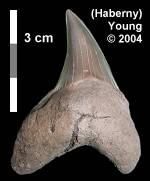 Keith Robertson discovered a 5-inch meg and smaller Carcharocles teeth were found by Rita McDaniel (3"), Bryan Butt (2") and Ted Kordela (1-3/4"). Cosmopolitodus teeth in the two-inch range were found by Don Ward, Tom Savisky, Tony Demonte and Steven Oliver (a 2-3/4" "xiphodon"). Notorynchus, especially lowers, were in abundance with specimens being collected by Vivian Ring, Mark Ladd, Don Ward, Marge Noel, Steve Wilson and others. The day's biggest surprise was Kim Greene's C. auriculatus (3/4") tooth, although Kathy (Haberny) Young's beautiful Paratodus (ref image) was a close runner-up. Keith Robertson and Judy Stiles both found shark noses, and although I did not get a look at Keith's, I will say that Judy's is one of the largest and most complete specimens I have seen come out of PCS. There were of course the "usual suspects", many Galeocerdo, silky, dusky, contortus, etc. teeth found by determined hunters. Keith Robertson discovered a 5-inch meg and smaller Carcharocles teeth were found by Rita McDaniel (3"), Bryan Butt (2") and Ted Kordela (1-3/4"). Cosmopolitodus teeth in the two-inch range were found by Don Ward, Tom Savisky, Tony Demonte and Steven Oliver (a 2-3/4" "xiphodon"). Notorynchus, especially lowers, were in abundance with specimens being collected by Vivian Ring, Mark Ladd, Don Ward, Marge Noel, Steve Wilson and others. The day's biggest surprise was Kim Greene's C. auriculatus (3/4") tooth, although Kathy (Haberny) Young's beautiful Paratodus (ref image) was a close runner-up. Keith Robertson and Judy Stiles both found shark noses, and although I did not get a look at Keith's, I will say that Judy's is one of the largest and most complete specimens I have seen come out of PCS. There were of course the "usual suspects", many Galeocerdo, silky, dusky, contortus, etc. teeth found by determined hunters.
Kathy Young brought out a complete bird bone and Kim Greene a bird vertebra. Keith Robertson found three associated sperm whale teeth and Steve Wilson a seal molar. Squalodon molars were picked by David Sanderson, Sharron Edwards and Ted Kordela (who also found a canine). Becky Hyne found a porpoise jaw with one tooth in it, Other whale material was plentiful, with many vertebrae coming out and a bulla. Steve Wilson found an nice Epitonium (gastropod) and John Everette and BJ both brought out echinoids. In all, the 2-inches of rain we got here last night and the newly opened areas provided a number of excellent specimens for today's visitors.
|
| November 6, 2004 |
|
Weekend 7: OK But Not Great
Pat Young reports:
Members of the Maryland Geological Society and Myrtle Beach Fossil Club were greeted by the first frost of the season. Reports of a small amount of rain the previous week had raised high hopes among collectors. Megalodon and chubutensis teeth were found, but not the hoped for first 5-inch specimen of the season. Ken Young brought out the largest tooth, a 4-1/4" meg which unfortunately had a dinged tip. Smaller ones, both megs and chubbies were found by Bob Johnson, Candace Holliday, Gael Decoudu, Rita McDaniel, Mike Horvat, Harry Chow, Jeff Wyatt, Ron Edwards and George Oliver. Dick Grier, Jr. found a neat posterior one that measured 1-1/4 inches wide and only 3/4 high. Cosmopolitodus hastalis teeth were fairly common in the 1-3/4 inch range and smaller. Galeocerdo cuvier teeth can only be called abundant with most collectors finding more than one. Becky Hyne found the only bramble shark tooth of the day. Quite a few Notorynchus teeth were found but only one upper was seen.
Marine mammal material was well represented by the two associated whale bullas and periotic processes found by George Powell. Teeth and vertebrae are still being found but only one Squalodon tooth (molar) was seen. Good quality fish fossils were quite readily collected by those desiring them.
Rain will continue to be the determining factor between a great season and a mediocre one — we need it badly.
|
| November 5, 2004 |
|
Correction
In the October, 31 'News', we reported that Rita McDaniel had found a Squalodon jaw fragment. That evening, several DVPS members and Rita had the chance to more closely examine the then cleaned specimen.

John Keklak presented the evidence for the specimen actually representing a gavial-type crocodile jaw.
"This was based on the following anatomical features: 1) the arterial scarring on the external bone surface is typical of crocodilian jaws, 2) the cross-sectional anatomy of the jawbone is more reptilian than mammalian in structure, 3) the bone is very dense (again more reptilian), and 4) the tooth does not project vertically from the jaw but at about 35 degrees from the vertical to the outside of the mouth. Furthermore, on this later point, the jaw section contains an adjoining socket for a second tooth. This socket indicates that the tooth projected at about 35 degrees in the opposite direction (i.e., toward the inside of the mouth). There is also a gap between the teeth to allow the teeth from the other jaw to mesh with them. This arrangement is consistent with what you have with the fish-eating crocs like Gavialosuchus. When their jaws are closed, the teeth are visible on the outside of the jaw, and alternating, corresponding teeth similarly project inside the mouth. The teeth also have a very pronounced curve toward the rear, again consistent with fish-eating crocs."
|
| October 31, 2004 |
|
Weekend 6: It's All in the Timing
Pat Young reports:
Aurora Fossil Club and American Fossil Federation members arrived at the parking lot Saturday morning greeted with the news that it had been another week without rain. Warm temperatures and gentle breezes made the 'Pungo crawl', which was employed almost exclusively, a bit easier to bear.
The largest Carcharocles of the day was Kim Greene's 2-inch Pungo specimen, followed by Matt Howard's Yorktown posterior (1-3/4") & 'chubbie' (1-1/2") and Brady Hamilton's tiny posterior tooth. Cosmopolitodus hastalis teeth are getting smaller with the largest reported tooth being Kim's 2-inch upper lateral. Much more plentiful were Notorynchus teeth (18) including Joanna Bove's beauty. Laura Norris found a partial Hexanchus lower. The smaller teeth (Hemipristis, Galeocerdo, Physogaleus, Carcharias, etc.) continue to be abundant.
John Whitsel found a very nice shark denticle and Kim Greene, a shark rostral node. A number of whale teeth were found, amongst which was Rita McDaniel's Squalodon jaw with one tooth intact (see correction above). Sandy Brenner and Becky each collected outstanding ray dermal scutes. Several nice bird bones were found including two by John Powell. Curiosities of the day included a pathologic P. contortus (two tips on one root) by BJ Blake, a horse tooth (Maria Thorne), a beautiful and complete whale bulla (Ellie Rouse), Kim Greene's echinoid (Echinocardium kelloggi) and an arrowhead sandollar (Encope sp) found by Eric Sadorf. Encope has not been previously reported from the mine (to my knowledge) and will be studied professionally.
Sunday saw the arrival of collectors from Catawba Valley Gem & Mineral, Delaware Valley Paleontological Society and NC Aquarium - Fort Fisher. Becky brought a Halloween treat to the day's collectors -- the news that the mine was extending the collecting area to the west (left in Sep 25 News image). Warmer than normal temperatures proved no barrier in our rush to these previously uncollected sediments.
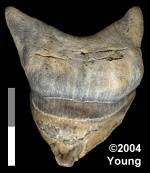 Almost immediately the 'meg shout' was employed, announcing a 4-1/2 inch Yorktown beauty by fossil guide Kim Greene. Things quieted after that as collecting intensified. Later, the parking lot 'show and tell' revealed Judy Larrick's first ever meg (4-1/2") and others found by Joyce Isaza (4-1/2"), Mike Keklak (4" Yorktown & 3-1/4" in Pungo matrix) and Hiroko Yokoe (3-3/4 & 2-1/4 lateral). The 2-1/2 inch and smaller range included finds by Eric Fritz, Jim Forster, Kathleen Baylies, John Everette, George Powell, Greg Auriemma and probably others. C. hastalis were abundant with most collectors bringing out at least one large example. Becky's topped the list at 3-inches with others over 2" found by John Everette, Bill Cheek, Wayne Bowman, Keith Robertson and Judy Larrick. Pristine Parotodus benedini teeth were found by Eric Sadorf, Judy Stiles and George Powell. Several very large Yorktown Hemis were taken including outstanding ones by Barbara Bauman and Kathleen Baylies. A beautiful Hexanchus lower (1-7/8") was collected by JoAnn Caffrey. John Keklak found a grossly pathologic meg (ref. attached).
Almost immediately the 'meg shout' was employed, announcing a 4-1/2 inch Yorktown beauty by fossil guide Kim Greene. Things quieted after that as collecting intensified. Later, the parking lot 'show and tell' revealed Judy Larrick's first ever meg (4-1/2") and others found by Joyce Isaza (4-1/2"), Mike Keklak (4" Yorktown & 3-1/4" in Pungo matrix) and Hiroko Yokoe (3-3/4 & 2-1/4 lateral). The 2-1/2 inch and smaller range included finds by Eric Fritz, Jim Forster, Kathleen Baylies, John Everette, George Powell, Greg Auriemma and probably others. C. hastalis were abundant with most collectors bringing out at least one large example. Becky's topped the list at 3-inches with others over 2" found by John Everette, Bill Cheek, Wayne Bowman, Keith Robertson and Judy Larrick. Pristine Parotodus benedini teeth were found by Eric Sadorf, Judy Stiles and George Powell. Several very large Yorktown Hemis were taken including outstanding ones by Barbara Bauman and Kathleen Baylies. A beautiful Hexanchus lower (1-7/8") was collected by JoAnn Caffrey. John Keklak found a grossly pathologic meg (ref. attached).
Whale material was plentiful with large sperm teeth being found by JoAnn Caffrey (4 associated), Joyce Isaza, Pat Holleman and Jeana Guzzello; many smaller ones were seen. Tom McKeeman retrieved an associated set of 5 small teeth (?Globicephela sp.), Ron Tillis and I each found one as well. Marlin rostra were found by Jeana Guzzello (lower), Jim Forster and Keith Robertson. Other finds included a seal canine (Paul Busovne), ray scute (Cathy Young), associated cetacean humerus, radius and ulna (George Powell) and a Squalodon canine.
|
| October 23, 2004 |
|
Weekend 5: Slower But Still Producing
Pat Young reports: Saturday's 41 collectors greeted each other with shivers as brisk winds whipped 48 degree air in the PCS parking lot. Despite there not having been any appreciable amount of rain the past week, members of the Delaware Mineralogical Society, East Coast Fossil Club, North Coast Fossil Club and 7 non-club affiliated collectors boarded the bus with inflated expectations.
As to be expected, the available teeth are getting smaller -- the largest Carcharocles specimen seen was a 2-3/4 inch tooth found by Dana McGuirt (who also picked up a 1-3/4 incher). Others were found by Jerry Britt (3-1/4" partial), Karissa Hendershot (1-1/2"), Becky Hyne (1-3/4"), Steve Pfaff (2-1/2"), Bob Asreen (1-3/4") and Dewayne Varnum (2" in matrix). Skylar Streich and Scott Wallace each found black Carcharodon carcharias teeth. A lovely Notorynchus symphyseal (1.0 x 1.0 cm) was found by Sophie Homsey. Lower cow sharks were collected by Karissa, Keith Robertson (2), Brian Smarella, Ellie Rouse (2) and Kim Greene; two uppers were also seen. Kim found a nice Echinorhinus cookei. Lower Cosmopolitodus hastalis were well represented by Jerry Britt's 2-5/8" mottled tooth, Dewayne Varnum's 2-1/8" and Jamie Harsell's 1-7/8-incher; all uppers were smaller. Mako teeth were best represented by Blair Venebles' 1-7/8 inch Isurus oxyrinchus. One Squatina was seen. Other smaller shark teeth continue to be plentiful.
Dewayne found 4-1/2 & 3-1/2 inch sperm whale teeth and Whitney Boone a 3-1/4 incher. A seal molar found by Pat, turtle toe bone by Becky and Squalodon molar by Blair were other highlights of the day.
Rain should definitely be on everyone's wish list for next week, but it doesn't look promising.
|
| October 16-17, 2004 |
|
Weekend 4: Results with little Rain
Cool mornings and temperate afternoons with brisk southern breezes made a great collecting weekend for members of the North Carolina Fossil Club, NC Museum, Calvert Marine Museum Fossil Club, New Jersey Paleontological Society and geology students from NC State University. Because of Becky's smooth handling of the transition to the new Safety Procedures instituted by PCS, we lost less collecting time than expected.
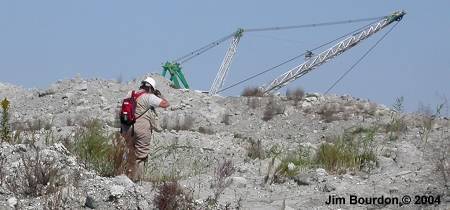
Saturday's top meg was a 4-1/4" specimen found by John Everette. Several smaller ones were found, including a great little posterior (3/4 x 1-1/8") by John Steffensen and a nice 1-3/4" chubbie found by Anne Lineberry. Cosmopolitodus hastalis teeth, although still plentiful, seem to be getting smaller, with the largest recorded specimen being a 2-inch broad-form found by Nancy Brown. Twelve lower Notorynchus and two uppers were seen. Perhaps the biggest surprise of the day was the recovery of nine partial Hexanchus teeth.
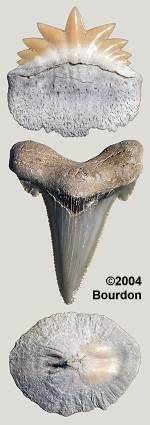 Mammal material was best represented by seal fossils: Vince Schneider managed to find a humerus, astragulus, (?)tibia and molar. Other seal specimens were: John Everette - humerus, Jim White - vertebra, and Nancy Brown - molar. Only a small chip on the tip kept Jeremy Jones' Squalodon incisor from being perfect. Ray material was best represented by Vince's butterfly-shaped scute.
Mammal material was best represented by seal fossils: Vince Schneider managed to find a humerus, astragulus, (?)tibia and molar. Other seal specimens were: John Everette - humerus, Jim White - vertebra, and Nancy Brown - molar. Only a small chip on the tip kept Jeremy Jones' Squalodon incisor from being perfect. Ray material was best represented by Vince's butterfly-shaped scute.
On Sunday, Jack Gollahon created quite a bit of interest with his 2-1/4-inch Carcharocles sokolovi tooth (see image), found in a Pungo washout. He also took top meg honors of the day with five other Carcharocles teeth ranging in size from 4-1/4 to 2-1/4 inches. Chubutensis teeth were also found by Dan Gitler, Brian Eelman and Bill Counterman (who also found a seal molar). Galeocerdo cuvier, Hemipristis serra and Physogaleus contortus teeth continue to be abundant. Several Notorynchus teeth (both uppers and lowers) were recovered, including a beautiful symphyseal found by Pam Platt (1.5 x 1.5 cm, imaged). Stingray dermal scutes were found by Kathy Young (2-1/4 x 2", imaged) and John Fagan. Various collectors brought out bird bones including two nearly complete carpometacarpi, three associated vertebrae and several partial specimens. Although this new collecting area exposes little of the Yorktown level 2 sediments that yield abundant quantities of otoliths, Trish Kohler found a very large and beautiful Astroscopus specimen. Rounding out the day's top finds were another unidentified fish skull with otoliths intact (John Nash) and an associated porpoise periotic & bulla (BJ Blake, imaged).
[Editor's note: About a half hour of collecting time was lost this weekend for compliance with the new security regulations. As these new procedures become routine, this time should decrease. This might be further alleviated if visitors were to arrive an additional 15 or 20 minutes earlier.]
|
| October 15, 2004 |
|
New PCS Requirement - Photo ID
PCS has put in new rules. Effective immediately, all collectors will be taken to the front gate to fill out forms AND show a photo ID. They will then be issued a temporary pass to enter the premises. No one will be allowed to enter without a photo ID. No particulars have been given out on the type of ID, but this usually means a state driver's license, government ID or passport.
|
| October 9, 2004 |
|
Weekend 3: Results without Rain
[Editor's note: Over the last couple years, the Lee Creek News has been written in such a way as to sanitize it of controversial terminology. In order to bring it in line with the rest of this website, we began this season replacing Triaenodon with Carcharoides, xiphodon with broad-form hastalis, Bramble shark with Prickly shark and using Carcharocles for megalodon and chubutensis. The last step was to stop using "mako" when referring to Cosmopolitodus hastalis teeth -- they are not makos but ancestral great whites. The term mako will be reserved for teeth ascribed to the true makos (Isurus) only.] Pat Young reports:
Dense fog, cooler temperatures and a bus still smelling of fresh PCS paint greeted the last forty-four members of the Friends of the Museum. Guided by Becky, this group descended on the pit with a serious collecting mindset. Although there had been no rain the previous week, it seemed not to affect the quantity of fossils recovered. Carcharocles and Cosmopolitodus teeth were nothing short of plentiful. Although not the giants of old, sheer abundance made up for that shortcoming.
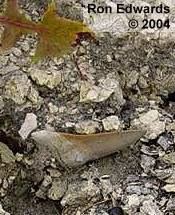 The largest meg of the day, a four-incher, left on the early bus without my getting a chance to get the name of the new owner; next was a 3-3/4 inch upper anterior found by Rita McDaniel. In the 2 to 2-1/2" class, Sarah Chapman, Al Chambers, Keith Robertson (in Pungo matrix), Bill Killen and Valerie Killen (posterior Yorktown) each found one, Gene Yates found three and Matt Wojtko & Jim Benedict each found four. Several smaller ones were located including three very tiny posteriors. Proving that knees-to-the-ground collecting is best, Ron Edwards provided the accompanying image of his 2-1/4" tooth, found nestled in weeds. Cosmopolitodus teeth (even more abundant than megs) were for the most part not as large but equally showy. Upper anterior specimens over 2-1/4" were recovered by Bill Blake & Scott Chapman (hastalis broad-form) and Debbie Wall & David Young (narrow-form). Aubrey Davis found a great 2-1/2" lower anterior and Cynthia Dyer's a 2-incher. Most left with a handful of smaller Cosmo teeth.
The largest meg of the day, a four-incher, left on the early bus without my getting a chance to get the name of the new owner; next was a 3-3/4 inch upper anterior found by Rita McDaniel. In the 2 to 2-1/2" class, Sarah Chapman, Al Chambers, Keith Robertson (in Pungo matrix), Bill Killen and Valerie Killen (posterior Yorktown) each found one, Gene Yates found three and Matt Wojtko & Jim Benedict each found four. Several smaller ones were located including three very tiny posteriors. Proving that knees-to-the-ground collecting is best, Ron Edwards provided the accompanying image of his 2-1/4" tooth, found nestled in weeds. Cosmopolitodus teeth (even more abundant than megs) were for the most part not as large but equally showy. Upper anterior specimens over 2-1/4" were recovered by Bill Blake & Scott Chapman (hastalis broad-form) and Debbie Wall & David Young (narrow-form). Aubrey Davis found a great 2-1/2" lower anterior and Cynthia Dyer's a 2-incher. Most left with a handful of smaller Cosmo teeth.
Carcharodon carcharias teeth were found by Matt, Debbie and Chris Herbstritt. Notorynchus teeth continue to attract collectors with lowers recovered by Bill Killen, Sharron Edwards, Chris Dyer, Becky, Debbie Wall, Keith Robertson and Joy Pierce Herrington (who found three). Uppers included those by Keith (2), Becky( 1) and Matt Wojtko (1). Becky also found two Hexanchus uppers (one with a twisted root and crown) to accompany her E. blakei home. Other pathological teeth were found by Keith (C. hastalis with a twisted crown), Dave Grabda (G. cuvier) and John Everette (Hexanchus upper).
Mammal material seemed plentiful; Valerie Everette took home three seal canines & a pilot whale tooth and Lisa Blakeslee a very nice Squalodon molar. Both John & Mike Keklak found cetacean humeri, and John also a seal astragulas. Fish vertebrae, including an outstanding marlin specimen found by Ken Young, continued to be plentiful. Bird bones, although found, were not complete.
|
| October 3, 2004 |
|
Weekend 2: Sunday — Still Producing
[Editor's note: Today's report was submitted by Howie Cohn of the New Jersey Paleontological Society who was in town on Saturday to complete his display at the museum and to collect with the Friends on Sunday. Howie's exhibit contains fossils from New Jersey, New York and Pennsylvania.]
Sunday started out mild as Becky brought us into the mine, but got hotter as the day progressed. The "Friends" who were collecting today recovered a wide variety of the more common fossils (for the Lee Creek mine).
Carcharocles teeth continue to be found but reflect the over abundance of Pungo tailings: George Powell (4-1/4, 2-1/2 & 1-1/2"), Eric Sadorf (2-3/4 & 2 3/4"), Paul Murdoch (2 & 3"), Becky (3/8" posterior) and Belinda Simmons (1-7/8 & 1-3/4"). Smaller sharks teeth were found by all: sand tigers, tigers, C. hastalis, P. contortus, carcharhinids and Hemis were the sharks represented. Whale, dolphin and seal specimens also left the mine, including vertebrae, ribs, skull and limb material.
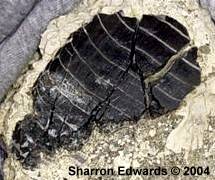 Some of the more interesting or less common finds included: John Everette a Squatina tooth, several bird bones including a coracoid and a seal vertebra; Ron Edwards' Parotodus benedini (1-3/4"); Lee Cone a marlin vertebra and whale bulla; Rita McDaniel a Prickly shark tooth and two Notorynchus; Mike Dunn's associated porpoise periodic and bulla; Howie Cohn's ray plate (cf Aetomylaeus, ref. image) in Pungo matrix (11-12 medial rows and 5 lateral teeth), three associated whale vertebrae and two associated whale teeth; and Kevin Dye's barracuda vertebra. Lastly, Jim White found a complete Pungo fish skull which still has the otolith pockets present — an outstanding find.
Some of the more interesting or less common finds included: John Everette a Squatina tooth, several bird bones including a coracoid and a seal vertebra; Ron Edwards' Parotodus benedini (1-3/4"); Lee Cone a marlin vertebra and whale bulla; Rita McDaniel a Prickly shark tooth and two Notorynchus; Mike Dunn's associated porpoise periodic and bulla; Howie Cohn's ray plate (cf Aetomylaeus, ref. image) in Pungo matrix (11-12 medial rows and 5 lateral teeth), three associated whale vertebrae and two associated whale teeth; and Kevin Dye's barracuda vertebra. Lastly, Jim White found a complete Pungo fish skull which still has the otolith pockets present — an outstanding find.
|
| October 2, 2004 |
|
Weekend 2: Saturday — Thanks Jeanne
Pat Young reports: Candace brought in the third group of 'Friends of the Museum' for a day of collecting on Saturday. The sunny skies and cool breezes made for a perfect fossil-hunting day. Some collectors rapidly headed to the rear of the pit in search of Yorktown treasures, while others chose a slower pace and began their search nearer the bus (mostly Pungo River).
A couple of medium-sized Carcharocles teeth were found, a complete 3-inch lower blond tooth in pristine condition and a 2-7/8" beauty, but most (generally Pungo - chubutensis) were much smaller. On this day, Notorynchus turned out to be the tooth du jour. At least twenty complete lowers were noted, along with two uppers and a symphyseal. The real winner for the day was John Bullett who went home with six lower teeth. 'Flipper' Burdette and Becky each found three; others were found by 'Friends' members George Wolf, Pam Platt and Joanne Dubrock. Five pathological teeth were found: Matthew Winthrow's large Notorynchus with unusual serrations, Becky's compressed and twisted hastalis anterior, a twisted G. cuvier and two split-tipped duskys. Prickly shark (E. cookei) teeth continue to appear in ever-growing numbers; BJ Blake & Joanne Dubrock each found one and Ken Young two. (It would appear that 3-years of Pungo crawling has greatly improved many eyes.) Ted Kordela found a large Parotodus benedini (2-1/4") which had suffered minor root damage, but was otherwise perfect. Broad-form hastalis ("xiphodon"), always a favorite, continue to be plentiful with Dave Sanderson taking home the day's largest (2-3/8"). BJ Blake found the largest narrow-form hastalis (2-1/4") and Pam Platt the largest mako, a 2-1/4" Isurus oxyrinchus.
A seal molar and incisor were picked up by Keith Robertson and others were collected by Sharron Edwards (molar) and Becky (canine). Becky also found a 12-inch marlin rostrum. Al Klatt brought out the most unique find of the day — eight associated fish (?puffer) vertebrae in what appeared to be upper Yorktown matrix. Bird bones continue to be found, but the condition seems to be declining.
In general, Jeanne refreshed the Pungo River tailings. Smaller teeth continue to appear in great abundance, and for a change, are really being appreciated by collectors. Their long exposure to the sun has produced some of the most beautiful color changes. Formerly black or gray Pungo teeth have been transformed into bright yellow and black streaks (Hemis), red and yellow in P. contortus & C. hastalis and sand tigers with golden crowns and jet black roots.
|
| September 26, 2004 |
|
The NCPC Block — It held up well
The true test of an area is how it can stand-up to a follow-up day of collecting. Becky Hyne brought out Sunday's Friends group on another beautiful, albeit a bit warmer, day. As can be seen from Pat Young's report, it was another excellent day.
 |
| Looking from NCPC Block collecting area towards future collecting area |
 The day's best meg came from the newly exposed Yorktown area — Ron Edward's 4-1/2" beauty. Seven more three-inch plus teeth were found, including Rich Olsen's 3-5/8" specimen. Another 18 complete Carcharocles teeth were less than three-inches in length — not bad. Hastalis teeth were again too numerous to count, but none were observed that would have measured much over 2-1/4 inches in length. As seen yesterday, most visitors came out with a large quantity of teeth. Deserving special mention were two Echinorhinus (Kim Greene and Ron Edwards), another Parotodus (Mac Lane's 1-3/4" upper lateral), a couple of Hexanchus (Lester Hall's lower and Fred Plumb's upper), over two dozen Notorynchus and Cindi Muston's Squatina.
The day's best meg came from the newly exposed Yorktown area — Ron Edward's 4-1/2" beauty. Seven more three-inch plus teeth were found, including Rich Olsen's 3-5/8" specimen. Another 18 complete Carcharocles teeth were less than three-inches in length — not bad. Hastalis teeth were again too numerous to count, but none were observed that would have measured much over 2-1/4 inches in length. As seen yesterday, most visitors came out with a large quantity of teeth. Deserving special mention were two Echinorhinus (Kim Greene and Ron Edwards), another Parotodus (Mac Lane's 1-3/4" upper lateral), a couple of Hexanchus (Lester Hall's lower and Fred Plumb's upper), over two dozen Notorynchus and Cindi Muston's Squatina.
Marine mammal material was still abundant, i.e., 10-inch diameter vertebrae still left untouched, plenty of teeth and ear material. Some of the highlights were seal teeth (Becky Hyne 2 molars and Doug Chaussee an incisor), sperm whale (Mac Lane's 4-1/2-incher and Rob Meltzer's set of associated 5-1/2-inchers), Squalodons (Becky's beautiful molar, Brian Hempy's canine and others) and much, much more. Almost five hours of digging by Fossil Guide George Powell and Friends member Doug Chaussee produced 14 associated whale vertebrae, one bulla, partial skull and other related fossil bones, which have been offered as a donation to the Aurora Fossil Museum.
Loads of fish specimens (premax, dentary, skull elements, etc) were seen. Darren Loomis found the weekend's second marlin predentary. Bird material remained common, including Clayton Smith's carpometacarpus and Doris Speicher's vertebra. Another croc tooth was found, this time by Jay Goldberg.
This weekend's reports have been long-winded (although culled from an even longer list provided by Pat), but the improvement has been so great that it seemed to be the best way to convey this change.
|
| September 25, 2004 |
|
The NCPC Block
Well, it was quite a day for the first forty-four collectors of the season — Friends of the Museum trip 1. It had been nearly five and a half years since the pit itself had been available to the public and expectations were high as Candace pulled the bus to a stop. Jeanne had hovered in the Atlantic long enough to allow for beautiful fall weather — blue skies, low-80 degree temperatures and a cooling breeze. The actual collecting area was smaller than previously described, maybe a 1/4-mile wide and a 1/2-mile deep (still plenty of room). There was a great deal of pure Pungo River exposures, but most of the area appeared to be lower Yorktown (units 1 & 2) overlying Pungo sediments. The lack of higher Yorktown exposures probably limited the size (but not quantity) of the recovered material. Overall, the results were reminiscent of the 'old days'. We are now collecting the source and namesake of those NCPC tailing we've been picking-over in recent years — the NCPC Block.
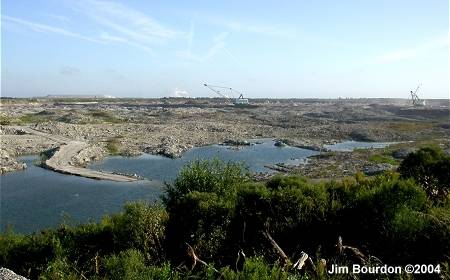 |
| NCPC Block collecting area as seen from bus parking area |
As was formerly the case, there will usually be two trips in and out. This presents a problem in that some collectors are gone before their results are recorded. Fortunately this day, Tom Caggiano covered the first bus and Pat Young the second.
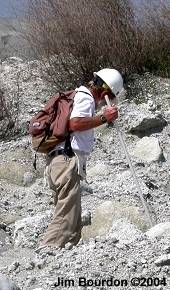 Carcharocles, mostly chubutensis, teeth were abundant. Four-inch plus specimens were found by Eric Sadorf & Carol Homan, three-inch plus by Jim White, Rita McDaniel, George Klein, Mike Folmer & Pat Young, and at least thirty smaller specimens by various visitors. Even more abundant were hastalis teeth. Many collectors had more than a dozen each, the largest being Paul Sangeorzan's 2-1/4 inch broad form. I'd estimate over half the visitors exited with 100-200 teeth. Of particular note were Chuck Ball's Parotodus, Prickly shark (E. cookei) teeth by Eric Sadorf & Kathy Hicks and Judy Stiles' near-perfect Hexanchus. At least a dozen Notorynchus were counted. George Klein surprised many by finding a very nice Carcharodon carcharias — James City tailings are very scarce. Ken Young found a striking ray barb which measured 7-1/4 inches, only the very tip was missing.
Carcharocles, mostly chubutensis, teeth were abundant. Four-inch plus specimens were found by Eric Sadorf & Carol Homan, three-inch plus by Jim White, Rita McDaniel, George Klein, Mike Folmer & Pat Young, and at least thirty smaller specimens by various visitors. Even more abundant were hastalis teeth. Many collectors had more than a dozen each, the largest being Paul Sangeorzan's 2-1/4 inch broad form. I'd estimate over half the visitors exited with 100-200 teeth. Of particular note were Chuck Ball's Parotodus, Prickly shark (E. cookei) teeth by Eric Sadorf & Kathy Hicks and Judy Stiles' near-perfect Hexanchus. At least a dozen Notorynchus were counted. George Klein surprised many by finding a very nice Carcharodon carcharias — James City tailings are very scarce. Ken Young found a striking ray barb which measured 7-1/4 inches, only the very tip was missing.
Marine mammal material (bones, ear material and teeth) was also abundant. Standouts were Carol Homan's 5-1/2" sperm whale tooth, Ron Edwards 3-inch whale tooth, three pilot whale teeth by Fred Ackerman and Squalodon teeth by Kim Greene, Tom Caggiano & Chris Mutilsteff. Seal jaw (with tooth) specimens were found by both John Everette and Mike McCloskey. George Powell and Steve Williams located eleven associated whale vertebrae to be collected at a later time.
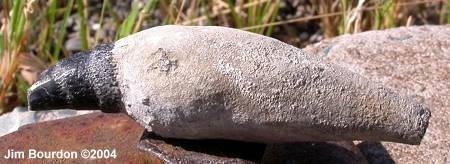 |
| Ron Edward's whale tooth |
Marlin material seemed unusually common. Chuck Ball found a great rostrum and Ramona Krailler a predentary (both were donated to the Aurora Fossil Museum). George Klein picked a partial marlin dentary, and a number of vertebrae were also taken. Fish material was generally abundant. At least a dozen bird bones were collected, most noteworthy was Chuck Ball's carpometatarsus. Andy Abdul found a nice croc tooth.
No one was heard to complain and it seems that all appreciated the new collecting area provided by PCS.
|
| September 17, 2004 |
|
Back to the Pit
Well, all the slots have been awarded and the "winners" notified. My club did pretty well — the NJPS got a mid-October date.
It had been long rumored that this season would see a return to the pit (and not the pitcar area). Well, Pat Young had a long conversation with Curtis Sr yesterday, and he confirms that there will be collecting in the pit! (Thank you Curtis.) It also seems the old Beckymobile has been retired, and a newer 35 passenger bus (2 trips?) will be available.
Sharron Edwards had the opportunity to see (not collect) the new area. She described it as huge (1-1/2 miles across) with plenty of great Yorktown and Pungo exposures. It has good hills (some slippery) and also some soft areas. It is staked off with red survey tape on the stakes. The official warning is:
"If anyone disobeys any of the safety rules, their complete group will be escorted out of the mine and will not be allowed back in the future. ...there will be no second chances or warnings, no excuses will be accepted."
Never been in the pit?
To those who never experienced pit-collecting, a walking stick is very useful, particularly when rain creates these soft flats and slippery slopes. Another difference is the time it takes to transverse the site. Sharron says it can easily take well over an hour to just reach the far side. So, just returning to the bus might be tricky — it's easy to get lost in the maze-like topography of the 'pit'. Unlike recent years, collectors will be in the pit for the day (no quick walk back to the bus). It is usually hotter in the pit, and a temperature in the 90s is possible — sufficient water must be carried in and loose, light-colored clothing recommended. In recent years, I've seen many visitors carrying 5-gallon buckets. This might work for those roadside tailings, but in the pit, bring a backpack. And remember, steel-toed shoes, and no tank-tops or shorts.
Weather — go away Jeanne
At the time of this writing, the 10-day Aurora forecast has a 30-60% chance of rain every day for the next 8 days. Sept 25 & 26th are shown to be partly cloudy and in the low-80s. That's pretty near perfect, but with Jeanne scheduled to hit GA-SC Thursday morning, this could all fall apart rapidly. Who knows, the 10-2 slot may be the first weekend.
|
| September 04, 2004 |
|
Member Slots & Lee Creek Teleosts
The 'general' collecting season slots haven't yet been awarded, but AFM member dates have been announced. I've heard of dates awarded for the 9-25 and 10-2 weekends. Based on AFM membership, members will probably be allocated 10-9 weekend slots as well.
Late last year, Pat Young and I were discussing the growing value of /interest in teleost material (considering the declining availability of elasmo fossils). Pat has been a longtime collector of teleost bones, and I'd been 'forced' to develop an interest in their otoliths. We concluded that attention to this material would be of interest to readers. Bill Heim joined the project, and we were determined to provide an overview for the fall 2004 season.
The scope and depth of our results has exceeded our original expectations. There is much more to tender, but this presentation should prove useful to some collectors. If you'd like to participate in this project, contact either Pat Young (bony material) or Jim Bourdon (otoliths). Visit Lee Creek Teleosts (if you don't have high speed access, give it time to load).
|
| August 10, 2004 |
|
Fall Season Slots
Pat Young reports that the PCS Public Affairs Dept. will be accepting emails between August 15th and August 20 for its Fall-2004 fossil collecting season. Please address all emails to: Curtis Ormond, Sr. at cormond@pcsphosphate.com with 'Fall Season-2004' as your subject. As in past years, hard-hats and steel-toed shoes will be required for mine entry. No sleeveless tops or shorts are allowed. The starting date for the fall season will be announced shortly.
|
| August 09, 2004 |
|
Website Update
It's been a pretty busy summer for elasmo.com. The website was moved to a new host which should be invisible to all. Some activities can be seen, such as additions to the dentitions slideshow and the incorporation of the Carcharoides catticus genus page (goodbye Triaenodon obsesus). Most of the efforts are not yet visible — most importantly a new Lee Creek Teleosts section. Pat Young, Bill Heim and myself have been working to provide a useful overview and guide to this fauna. It is scheduled to go live prior to the beginning of the collecting season.
|
|
|